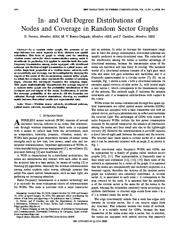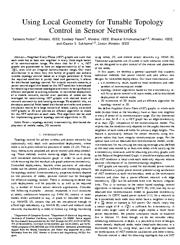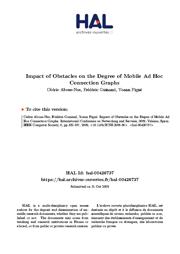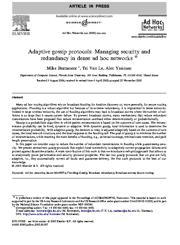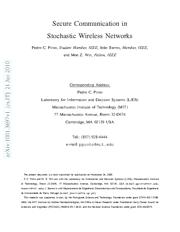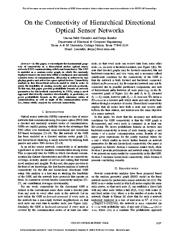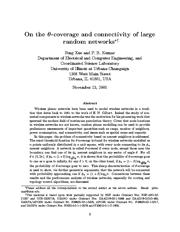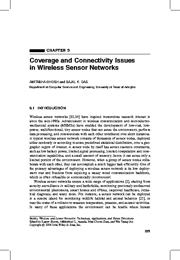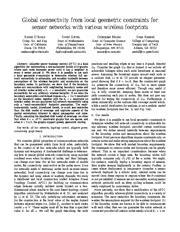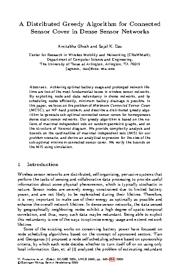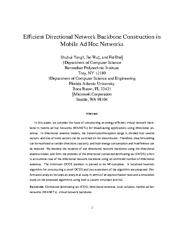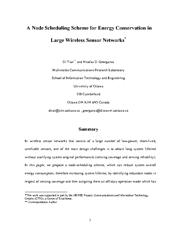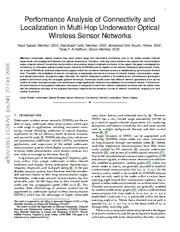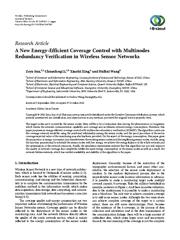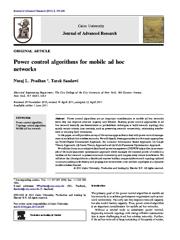A copy of this work was available on the public web and has been preserved in the Wayback Machine. The capture dates from 2016; you can also visit the original URL.
The file type is application/pdf.
Filters
In- and Out-Degree Distributions of Nodes and Coverage in Random Sector Graphs
2014
IEEE Transactions on Wireless Communications
This paper mathematically characterizes the average degree of a random sector graph and the probability distributions of the in-degree and out-degree of the nodes. ...
In a random sector graph, the presence of an edge between two nodes depends on their distance and spatial orientation. ...
OUT-DEGREE DISTRIBUTION In a random sector graph, the out-degree of a node is given by the number of other nodes inside its circular sector. ...
doi:10.1109/twc.2014.031314.130905
fatcat:t3bxpdgqrfbrzfoujremqb54fe
Using Local Geometry for Tunable Topology Control in Sensor Networks
2009
IEEE Transactions on Mobile Computing
In controlled deployment of a mobile network, control over positions of nodes can be leveraged for constructing NET graphs with desired levels of network connectivity and sensing coverage. ...
Neighbor-Every-Theta (NET) graphs are such that each node has at least one neighbor in every theta angle sector of its communication range. ...
It turns out that for em NET graphs also there is relation between minimum node degree and edge-connectivity. In NET graphs every interior node has a degree of at least 2π θ . ...
doi:10.1109/tmc.2008.95
fatcat:v6n7uanehzcp3nbxtbf6dngk7a
Impact of Obstacles on the Degree of Mobile Ad Hoc Connection Graphs
2009
2009 Fifth International Conference on Networking and Services
Coupled with a simple model of radio propagation, and according to the density of stations in the environment, we study the mean degree of the connection graphs corresponding to such mobile ad hoc networks ...
What is the impact of obstacles on the graphs of connections between stations in Mobile Ad hoc Networks? ...
Coverage in Presence of Obstacles In order to obtain an estimation of the mean degree of the connection graph, we need, additionaly to the density distribution of presence of station, their coverage, depending ...
doi:10.1109/icns.2009.36
dblp:conf/icns/Aboue-NzeGP09
fatcat:fltqyhn7vzelbnej7y4hoehn5a
Adaptive gossip protocols: Managing security and redundancy in dense ad hoc networks
2007
Ad hoc networks
The goal of gossip is to minimize the number of retransmissions, while retaining the main benefits of flooding, e.g., universal coverage, minimal state retention, and path length preservation. ...
In this paper we consider ways to reduce the number of redundant transmissions in flooding while guaranteeing security. ...
In the six sector model, this error allows an upper bound of a worst case uncovered area of thirty degrees. ...
doi:10.1016/j.adhoc.2005.11.007
fatcat:gyha3swsgbfbrh3fjgfrzwchwu
Secure Communication in Stochastic Wireless Networks
[article]
2010
arXiv
pre-print
Conclusive results are provided for the local connectivity of the Poisson iS-graph, in terms of node degrees and isolation probabilities. ...
Based on a general model in which legitimate nodes and potential eavesdroppers are randomly scattered in space, the intrinsically secure communications graph (iS-graph) is defined from the point of view ...
Shen, and W. Swantantisuk for their helpful suggestions. 20 In the literature, the Mellin transform is sometimes defined differently as MX (s) ...
arXiv:1001.3697v1
fatcat:l3kvrj4ubnayxkkjdxsxgtynru
On the Connectivity of Hierarchical Directional Optical Sensor Networks
2007
2007 IEEE Wireless Communications and Networking Conference
The OSN is modeled as a random sector graph, in which the randomly deployed sensors can send data within a contiguous and randomly oriented sector of communication. ...
Connectivity analysis in this hierarchical network model is vital in order to assess the feasibility of routing, security and network protocols. ...
Nodes in {S + i }) are called S i ' G n is S − = E(S − i ) . The out and in degrees of S i is the sum along the i th row and i th column of E respectively.
IV. CONNECTIVITY ANALYSIS A. ...
doi:10.1109/wcnc.2007.646
dblp:conf/wcnc/OkoraforK07
fatcat:xrkkuqdpkjbz5pnnxwx55vli24
On the /spl theta/-coverage and connectivity of large random networks
2006
IEEE Transactions on Information Theory
A network is called θ-covered if every node, except those near the boundary, can find one of its φ n nearest neighbors in any sector of angle θ. ...
The exact threshold function for θ-coverage is found for wireless networks modelled as n points uniformly distributed in a unit square, with every node connecting to its φ n nearest neighbors. ...
So the factor log n is the price caused by randomness in order to get θ-coverage for every node in the network of n nodes. Theorem 2. ...
doi:10.1109/tit.2006.874384
fatcat:4p4gwbczazh27pr4oiiflbefby
Coverage and Connectivity Issues in Wireless Sensor Networks
[chapter]
2006
Mobile, Wireless, and Sensor Networks
A typical wireless sensor network consists of thousands of sensor nodes, deployed either randomly or according to some predefined statistical distribution, over a geographic region of interest. ...
Advancement in wireless communication and microelectromechanical systems (MEMSs) have enabled the development of low-cost, lowpower, multifunctional, tiny sensor nodes that can sense the environment, perform ...
Graph Connectivity In the previous sections, we introduced the concept of degree of coverage and connectivity; here we provide formal definitions for those concepts in terms of node degree and connectivity ...
doi:10.1002/0471755591.ch9
fatcat:tp6jlaujzndgfjnsokhvlfslh4
Global connectivity from local geometric constraints for sensor networks with various wireless footprints
2006
Proceedings of the fifth international conference on Information processing in sensor networks - IPSN '06
Adaptive power topology control (APTC) is a local algorithm for constructing a one-parameter family of θ-graphs, where each node increases power until it has a neighbor in every θ sector around it. ...
The weakmonotonicity model, introduced herein, is much less restrictive than the disk model of coverage and captures aspects of the spatial correlations inherent in signal propagation and noise. ...
Considering the stronger constraint θ = 2π/3, the expected out degree is higher, yet the graph still sparse. In this case A = 2/3. ...
doi:10.1145/1127777.1127784
dblp:conf/ipsn/DSouzaGMR06
fatcat:y3m7x3psqvebtg6okm5cgrwium
A Distributed Greedy Algorithm for Connected Sensor Cover in Dense Sensor Networks
[chapter]
2005
Lecture Notes in Computer Science
Our greedy algorithm is based on the notions of maximal independent sets on random geometric graphs, and on the structure of Voronoi diagram. ...
By exploiting node and data redundancy in dense networks, and by scheduling nodes efficiently, minimum battery drainage is possible. ...
We use the notions of maximal independent sets (MIS) on random geometric graphs and the structure of Voronoi diagram to find out sub-optimal MCSC. ...
doi:10.1007/11502593_26
fatcat:2zpy6a7jnjhwrgnfpioacnmbly
Efficient Directional Network Backbone Construction in Mobile Ad Hoc Networks
2008
IEEE Transactions on Parallel and Distributed Systems
Due to the constraints of the signal coverage area, interference can also be reduced. they are special cases of directed graphs. ...
The minimum DCDS problem is not a trivial extension of the minimum CDS problem. This is because there may be more nodes in the minimum DCDS than in the minimum CDS of a graph. ...
distributed to generate the geometric graph. ...
doi:10.1109/tpds.2008.43
fatcat:n2dpi2attzcwbpblf3pygmliv4
A node scheduling scheme for energy conservation in large wireless sensor networks
2003
Wireless Communications and Mobile Computing
In this paper, we propose a node-scheduling scheme, which can reduce system overall energy consumption, therefore increasing system lifetime, by identifying redundant nodes in respect of sensing coverage ...
performances (sensing coverage and sensing reliability). ...
Acknowledgement The authors are grateful to the anonymous reviewers for their many useful comments and constructive suggestions that improved the quality of this paper. ...
doi:10.1002/wcm.116
fatcat:hmz4nmbdyjc7jle7zalyqu5wqu
Performance Analysis of Connectivity and Localization in Multi-Hop Underwater Optical Wireless Sensor Networks
[article]
2018
arXiv
pre-print
outperforms the literature in terms of network connectivity, ranging error, and number of anchors. ...
Firstly, we model UOWSNs as randomly scaled sector graphs where the connection between sensors is established by point-to-point directed links. ...
In [20] , the authors have analyzed the coverage probability of random sector graphs for RF wireless sensor networks. ...
arXiv:1811.11247v1
fatcat:xvlxrftcxnbl3lvnkwovq5meze
A New Energy-Efficient Coverage Control with Multinodes Redundancy Verification in Wireless Sensor Networks
2016
Journal of Sensors
The algorithm constructs the coverage network model by using the positional relationship among the sensor nodes, and the proof procedure of the sector coverage expected value of the monitoring area also ...
The target nodes are k-covered by the sensor nodes; there will be a lot of redundant data forcing the phenomenon of congestion which lowers the network communication capability and coverage and accelerates ...
The sensor node that satisfies the condition in the CL is sorted out and the message "inf notice" is sent out to start the effective coverage. ...
doi:10.1155/2016/2347267
fatcat:w6jlwegp4vfy3lyf4w65xxfkuq
Power control algorithms for mobile ad hoc networks
2011
Journal of Advanced Research
We will show that the algorithm in a distributed manner builds a unique stable network topology tailored to its surrounding node density and propagation environment over random topologies in a dynamic ...
We will classify these approaches into five main approaches: (a) Node-Degree Constrained Approach, (b) Location Information Based Approach, (c) Graph Theory Approach, (d) Game Theory Approach and (e) Multi-Parameter ...
Different nodes in the network can have different degrees and the minimum node degree of the network is given by k min ¼ min 8i2N kðiÞ ð 2Þ The Degree Distribution Function P(k) of a network is defined ...
doi:10.1016/j.jare.2011.04.009
fatcat:7cupaqzbwrg7laqffacxilgrt4
« Previous
Showing results 1 — 15 out of 7,471 results

